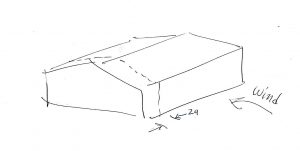`Corners’
(c) Jeff R. Filler, Pell City, April 2023
In earlier posts we looked at the `main’, or `overall’, wind forces on a rather low, wide `shop’ (here and here), and on a relatively narrower and taller `house’ (here). Specifically, we calculated the Main Wind Force Resisting System (MWFRS) forces hitting the structures from the `side’ (long dimension). We calculated the forces per 8-foot `swath’ of building, as the shop was framed in 8-foot column-truss-column bents. We found that, overall, the wind forces tend to `lift’ a low, wide building off the ground (or roof off the wall), with perhaps a bit of pushing and prying due to the horizontal component of wind load, while for a narrower, taller (and steeper-roof) residence, the wind tends to push the house off its foundation … the horizontal components of wind force being greater than the vertical (upward) components. The comparison is often exaggerated as the roofs of `shop’ type buildings are generally light (small roof dead load) … there’s little dead weight helping hold the roof, or building, down.

We might very well design the MWFRS elements (bents of columns-trusses-columns) of the shop, and the main wind-force resisting system of the house, utilizing the forces we obtained in the MWFRS analysis, but before we do so, let’s look at the `corners’. ASCE 7-22 Figure 28.3-1 shows us what MWFRS pressure coefficients to use for corners. A quick look shows them to be roughly 50 percent more than `away’ from the corners. The amount of the walls and roof surfaces upon which these pressures act are denoted by a and 2a, where a is the lesser of 10% of the building width and 40% of the mean roof height, but not less than 4% of the building width (least horizontal dimension) or 3 feet (ft), and so on. For our 40 ft by 100 ft shop with 4/12 roof, a is the lesser of 0.1 x 40 ft = 4 ft and 0.4 x ~ 12 ft = 5 ft, but not less than 0.04 x 40 ft = 1.6 ft or 3 ft … or … 4 feet. 2a = 8 ft. So, the end 8 feet of 100 feet of side wall is affected by the higher pressures. The MWFRS forces were good when looking at the MWFRS away-from-corner bents. The end bents, and the next ones in, have higher pressures. What about the other end (corner)? Yeah, the other corner (other end) needs to be considered, but not simultaneous with the first. Going back to Figure 28.3-1, there are 2 Load Cases. Case 1 is with the wind hitting the side, and at some angle. Case 2 is the wind hitting the end, and at some angle. Each Case has 4 corners, one at a time. So, yeah, there are 8 overall building loading conditions to examine. It’s nice if the building has a lot of symmetry, especially if you’re doing the calculations by hand. At any one time, only one corner (8 percent of the side wall in the example) experiences the `corner’ pressures.
Go look at structures damaged by wind. The damage is at, or starts at, the corners.